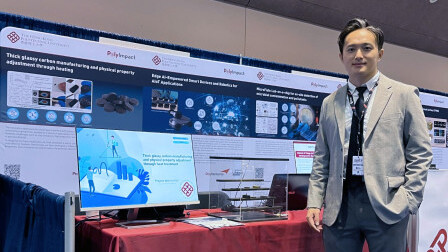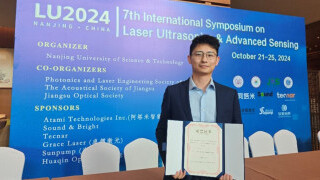Advanced Fluidic Fabrics: Pioneering Material Innovations for Enhanced Thermal Therapy
Other Articles

Leveraging cutting-edge wearable fluidic fabric for rapid skin temperature modulation.
Study conducted by Prof. Xiaoming TAOand her team
Rapid temperature contrast hydrotherapy, also known as contrast water therapy, involves alternating immersion in hot and cold water to aid in sports recovery Note1. By rapidly switching between these temperature extremes, the therapy aims to invigorate the body's natural healing processes, making it a popular choice for athletes and individuals seeking relief from muscle soreness, joint pain, and stress. As a result, contrast water therapy is an effective strategy for enhancing overall athletic performance and facilitating faster recovery after competitions. Traditionally, contrast water therapy involves using two baths filled with cold and hot water respectively at precisely controlled constant temperatures Note2. However, the facilities and significant water consumption required restrict the application of this therapy in daily athletic training. Existing wearable cooling and heating systems often struggle with limited heat transfer rates between the device and the human body, failing to meet the requirement for practical contrast water therapy.
A study published in Advanced Science highlights a breakthrough developed by a research team led by Prof. Xiaoming TAO, Chair Professor of Textile Technology of the School of Fashion and Textiles and Vincent and Lily Woo Professor in Textile Technology at The Hong Kong Polytechnic University. The team created a novel portable system based on a wearable fluidic fabric device to facilitate rapid skin temperature modulation [1]. The innovative system enables athletes to experience the benefits of contrast water therapy without the need for actual water immersion.
The system comprises several key components, which include wearable fluidic fabrics, a small water tank (with a volume of three litres, designed for one leg), a control machine for temperature regulation, a water pump, and a connection tube (Figure 1). The wearable fluidic fabrics are designed with multiple layers to optimise performance. These layers include an outer thermal insulation fabric layer for reducing heat transfer between fluid and the surrounding environment, a middle flexible heat transfer panel (FHTP) layer, and an ultra-thin inner fabric layer that is in contact with the skin (Figure 2). The core FHTP layer consists of two pieces of laminated fabrics that are joined together by one-step welding. To achieve a uniform and rapid cooling/heating effect, the FHTP is designed with both serpentine and network channel patterns (Figures 3 & 4).
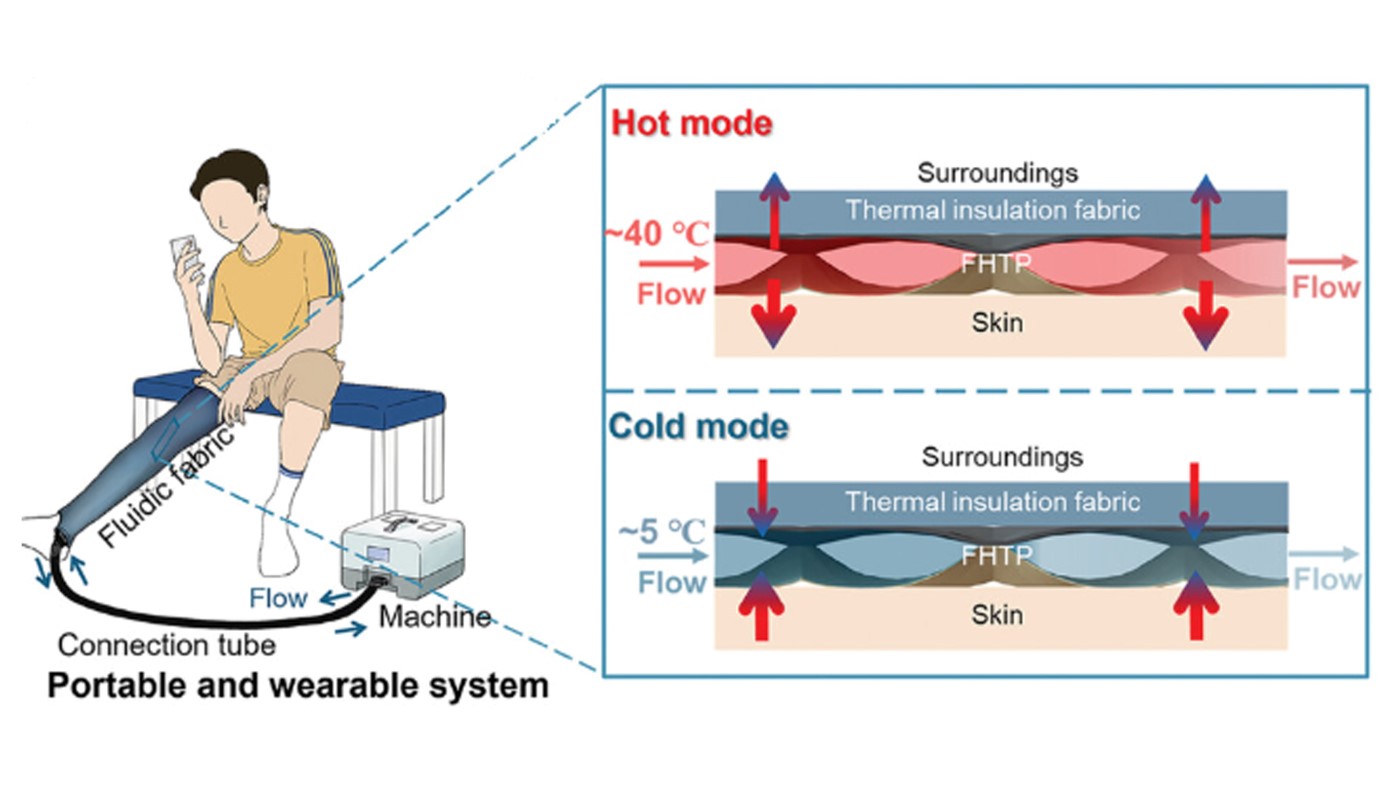
Figure 1. Schematic of the proposed portable and wearable system for rapid contrast therapy. Water is pumped from the tank in the control machine into the fluidic fabrics, and then recirculated back to the tank. The wearable fluidic fabric consists of a flexible heat transfer panel (FHTP) and a piece of thermal insulation fabric. When cold or warm water flows through the fluid channel of the FHTP, heat is transferred from high to low-temperature regions, thereby cooling or warming the skin and the surroundings. The heat flux is indicated by arrows.
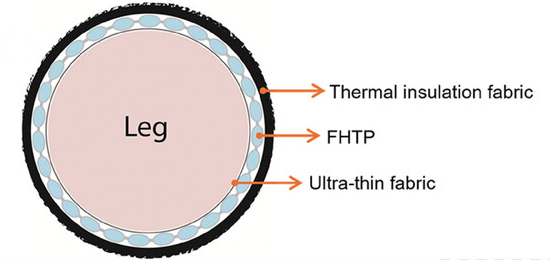
Figure 2. The composite fabric structure of the wearable fluidic fabric from the cross-sectional view: an outer thermal insulation fabric layer, a middle FHTP, and an ultra-thin inner fabric in contact with the skin.
The system features rapid cooling/heating transitions within ten seconds over an effective area of 0.3 square metre. Using a smartphone app, users can initiate the temperature therapy program, which allows either warm or cool water to be pumped from the tank into the channels within the fabric before being recirculated back into the tank. Each therapy cycle comprises two distinct modes: cold mode and hot mode. In the cold mode, the temperature of circulating water is set to approximately 5 °C for one minute. In this mode, the flowing water absorbs heat from the skin and the surrounding environment. In the hot mode, the water temperature is raised to 40 °C for two minutes. During this phase, heat is dissipated into the skin and the surroundings.
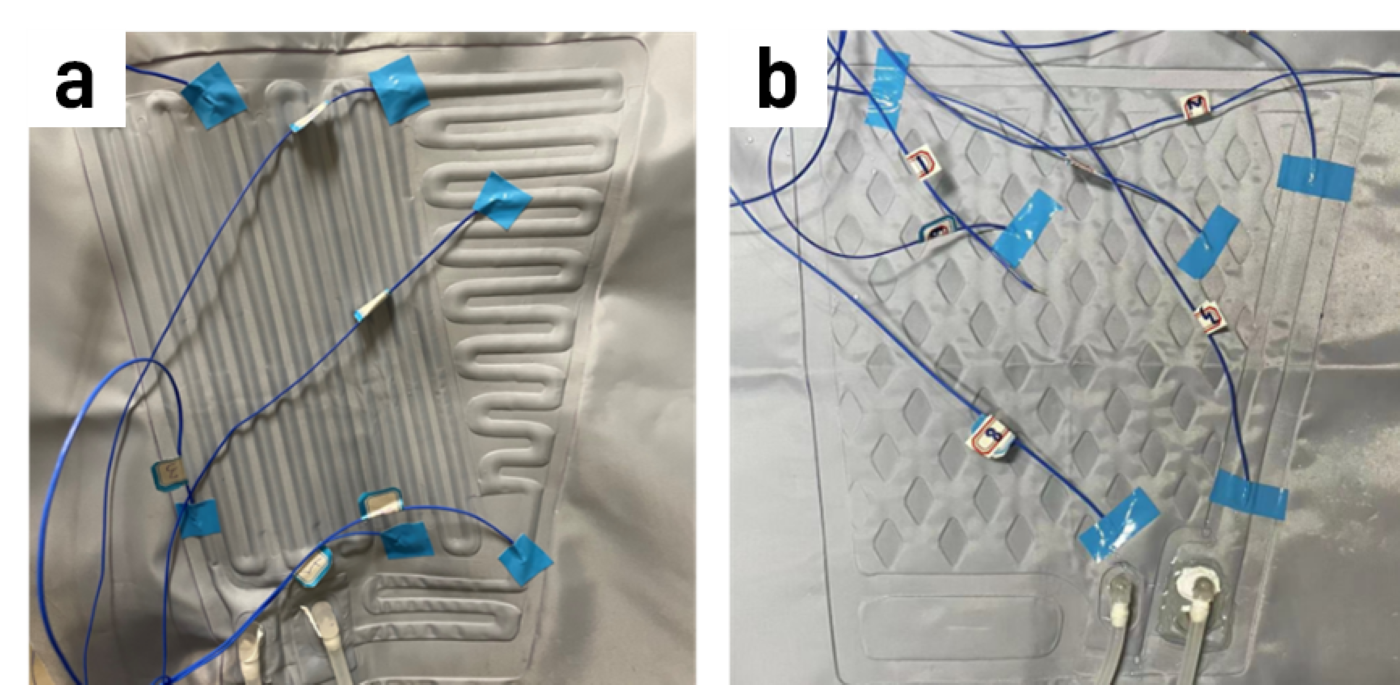
Figure 3. The FHTPs are fabricated in two fluid channel patterns. a) Serpentine channel pattern. b) Network channel pattern. To evaluate temperature uniformity, six k-type thermocouples were randomly placed on the surface of the FHTPs.
The wearable fluidic fabric device exhibits exceptional heat transfer properties. During cold therapy, the heat transfer coefficient measured between the skin and the fabric is 98.5 W m⁻² K⁻¹. This performance translates to an impressive 92% efficiency compared to direct water immersion, significantly surpassing that of benchmark liquid cooling garments, which typically exhibit heat transfer coefficients ranging from 13 to 37 W m⁻² K⁻¹. Overall, the FHTP demonstrates strong heat transfer capability. Specifically, the heat transfer effectiveness of the FHTP reaches up to 89% during cold therapy and approximately 55% during hot therapy.
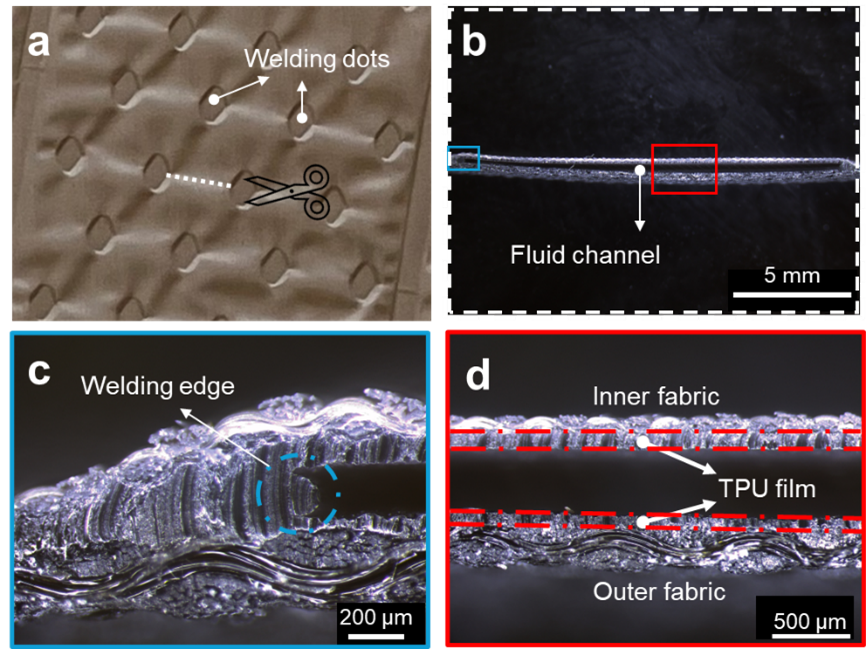
Figure 4. Surface and cross-sectional images of the FHTP. A) Photo of the FHTP with rhombus welding dots B) Cross-sectional images of the fluid channel with an approximate width of 15 mm C) Magnified image near the welding dot D) Magnified image of the fluid channel
This study marks a significant breakthrough in the development of wearable fluidic fabric capable of rapidly modulating skin temperature within a wide range—from 5 °C to 40 °C. In addition to its effectiveness in contrast water therapy, this innovative fluidic fabric presents extended potential applications in skin thermal management for medical purposes as well as in extreme situations such as encountered during fire protection activity.
The research is supported by the Sport Science and Research Funding Scheme of the Hong Kong SAR Government and Hong Kong Jockey Club Charities Trust [No. P0042455], as well as the Endowed Professorship Fund of The Hong Kong Polytechnic University [No. 847A]. The data source and code can be obtained from the corresponding authors upon request.
Prof. Tao has been recognised by Stanford University as one of the top 2% most-cited scientists worldwide (career-long) in the field of materials for six consecutive years from 2019 to 2024. In acknowledgement of her outstanding contributions and expertise in engineering, she was elected as a Fellow of the Hong Kong Academy of Engineering in 2025. Currently, Prof. Tao serves as the Director of the Research Institute for Intelligent Wearable Systems at The Hong Kong Polytechnic University.
| Notes |
|---|
This technique utilises the physiological effects of temperature changes to enhance circulation, reduce muscle soreness, and decrease inflammation. During the hot water phase, blood vessels dilate, leading to increased blood flow that delivers vital oxygen and nutrients to fatigued muscles. Conversely, the cold-water phase causes blood vessels constriction, which helps reduce swelling and flush out metabolic waste products.
Lower-body immersion requires approximately 100 litres of water.
Reference |
|---|
[1] Yang, J., Xiong, Y., Piao, J., Leung, M., Liu, G., Zhu, M., Tang, S., Zhang, L., & Tao, X. (2025). Wearable Fluidic Fabric with Excellent Heat Transfer Performance for Sports Recovery. Advanced Science. https://doi.org/10.1002/advs.202411691
 | Prof. Xiaoming TAO Vincent and Lily Woo Professor in Textile Technology Director of Research Institute for Intelligent Wearable Systems |



